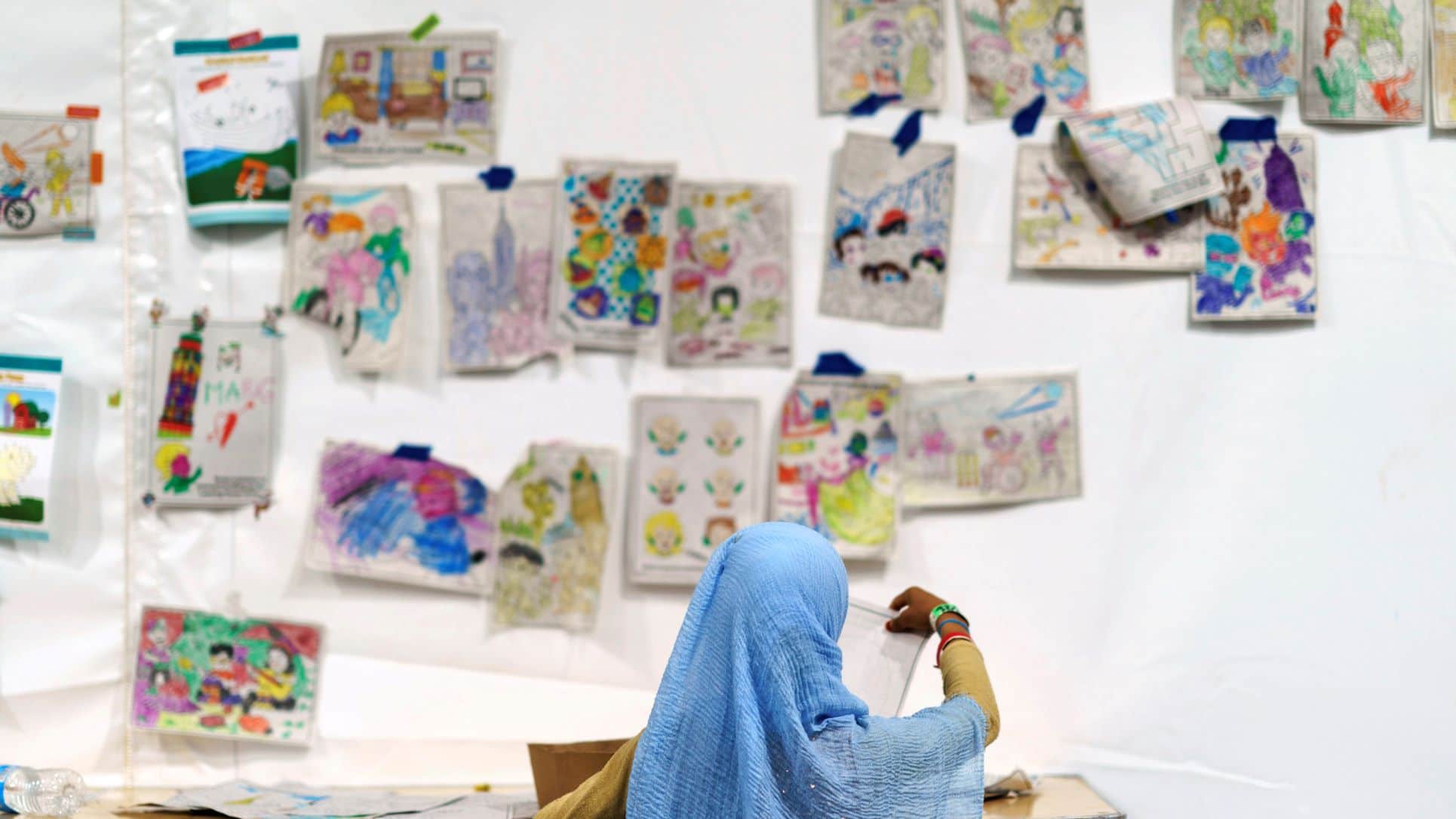After Kabul fell to the Taliban, the hurried evacuation of Afghans and COVID-19 have complicated efforts to find the refugees new homes overseas.

A child holds up a piece of artwork while drawing in a tent at U.S. Fort Bliss, in New Mexico, where Afghan refugees are being housed, 10 September 2021. (AP Photo/David Goldman)
When Kabul fell to the Taliban in August, many Afghans fled the country as quickly as they could. The world watched as desperate men and women occupied the Kabul airport and ran along the runway while U.S. military forces left the country after 20 years of military intervention.
Up to half a million Afghans may leave the country by the end of the year. Yet most fleeing their homes will remain in the country as internally displaced peoples.
Of those who leave Afghanistan, most will pass into neighbouring Iran and Pakistan. Some will seek refugee status in countries outside the region that are accepting immigrants, including the United States, United Kingdom, Canada and France. Much of Europe, including Turkey and Greece, is resisting Afghan arrivals for fear of a repeat of the Syrian refugee crisis in 2015.
The speed of this evacuation, in addition to the challenges of navigating a global pandemic, has left receiving countries struggling to accommodate and house Afghans.
“The rapid evacuation, particularly out of Kabul, has resulted in having to create a system in a build-it-as-you-do-it way,” said Marie Olenych, director of refugee and trafficking services at the U.S. Committee for Refugees and Immigrants (USCRI) in Arlington, Virginia. The USCRI has supported around 2,500 Afghans thus far, primarily special immigrant visa holders or humanitarian parolees.
U.S. has resorted to makeshift measures to accommodate some Afghan refugees.
The United States has received 64,000 Afghan refugees since August and expects to welcome up to 125,000. Olenych said the country’s settlement agencies were not prepared to accept such large numbers of refugees when they started arriving. That is in large part because the United States saw a dramatic decline in refugee arrivals during the administration of former President Donald Trump, and as a result many settlement agencies were understaffed and even had closed their doors.
U.S. settlement agencies have a lot of work to do to get back to their previous levels of resettlement capacity.
“There were a lot of measures that increased the amount of time it takes refugees to go through the process,” said J.C. Hendrickson, senior director for policy and advocacy at the International Rescue Committee. “Some of those were discriminatory and had a disproportionate impact on people of color and Muslims.”
As a makeshift solution, the U.S. Department of Defense set up eight military bases to house refugees until more permanent options are available.
“This is because of the nature of the way the U.S. evacuated. It is not because of COVID, and it is not a standard practice,” Olenych said. The military bases are already almost filled to capacity, with more Afghans waiting to arrive at U.S. bases in the Middle East, Spain and Germany.
Canada and the UK have opted to convert hotels into emergency shelters for refugees to ensure they have enough space to quarantine. Overcrowding remains an issue, and many feel cooped up in the hotels without the opportunity to leave.
On the military bases, arrivals must quarantine and receive vaccinations for COVID-19, measles, mumps, rubella and polio. Outbreaks of measles have delayed the process of moving refugees out of the military bases, while COVID-19 numbers have remained modest. Olenych said USCRI is relocating refugees to 41 sites across the United States, with Virginia, northern California and Texas being the most popular locations.
After evacuation, housing is the biggest challenge.
The biggest obstacle to resettlement has been finding housing.
“The U.S. has a very low inventory of housing right now,” Olenych said. “Rental properties are largely not available in some of our major cities.” The USCRI is relying to some extent on ties that refugees might have with existing family or friends of Afghans who can assist with housing, especially in cities where the cost of living is high.
Some companies have stepped up to help. Airbnb has pledged to provide temporary housing for 40,000 Afghan refugees. A coalition of 33 companies, including Amazon, Walmart and TripAdvisor, is offering employment to Afghans.
Many of the companies offering assistance are in the hospitality industry, which has been hit hard by COVID-19 and is looking to bounce back. The industry has historically been friendly towards the hiring of newcomers. Olenych believes these opportunities are being offered because many Americans see the Afghan arrivals as allies to the U.S. military.
“This particular population is valued by members of the general population of the U.S.,” Olenych said.
Most Afghans arriving in the United States have some connection to the U.S. military. They include interpreters and mechanics, as well as journalists at risk under the Taliban regime.
These individuals generally arrive with their families. Because of the types of jobs they held in Afghanistan, most of the heads of households, who are predominantly male Afghans, have advanced English skills, making their resettlement journey much smoother than those needing to learn the language.
Beyond housing, the next biggest hurdle to resettlement is ensuring adequate health care, employment, cultural orientation and English language lessons for those who are not fluent. As with any resettlement, the journey can be long, frustrating and complicated.
In this case, the process has been compressed in time, necessitating makeshift solutions to resettle these vulnerable populations, while protecting both the refugees and their new hosts from the coronavirus pandemic.
Questions to consider:
- What are some of the challenges to resettling Afghan refugees, and what are some of the proposed solutions?
- How is resettlement complicated by COVID-19?
- What do you think are some of the challenges an Afghan family might face during the first few years of resettlement in a foriegn country such as the United States?

Natasha Comeau is a former fellow in global journalism at the Dalla Lana School of Public Health at the University of Toronto. She holds a Master of Global Affairs from the Munk School at the University of Toronto. She currently works at Grand Challenges Canada, a nonprofit based in Toronto, where she supports global health innovations in low and middle-income countries.
